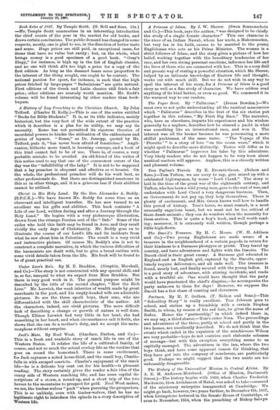The History of the Universities' Mission to Central Africa. By
A. E. M. Anderson-Morshead. (Office of Mission, Dartmouth Street.)—The history begins with 1859, when Charles Frederick Mackenzie, then Archdeacon of Natal, was asked to take command of the missionary enterprise inaugurated at Cambridge. We might go back, however, two years further, to December 4th, 1857, when Livingstone lectured in the Senate House of Cambridge, or even to November, 1854, when the preaching of Bishop Selwyn kindled the fire of missionary zeal in Mackenzie's heart. The first location that the mission took was at Chibisas, on the Shire, and the date was July 8th, 1861. It came at what may well seem an unfortunate time, for there had been a great disturbance in local politics which the missionaries, and even Livingstone, who was their chief adviser, did not understand. The missionaries interfered, and, indeed, as it seemed:could hardly help interfering, with local affairs. The complication has never come to an end and probably never will. Possibly non-resistance is the only sound principle for the missionary. But it was against the grain of an Englishman's nature, and when it comes to standing by and letting the slave-hunter do his wicked work with impunity it becomes almost impossible. The Bishop died of fever on January 31st, 1862,—it will be remembered that his party had lost their stock of quinine. About three months later
the first church was built. It was made of reeds, and the archi- tect was Clark, a shoemaker. He deserves to be remembered among the pioneers. Mr. Burrage had diod three weeks after the Bishop ; on the first day of the next year Mr. Scudamore followed him, and Dr. Dickenson, "to whom almost every one of the Mission owed his life," passed away two months later. Dr. Tozer, the second Bishop, came out in June. We cannot follow the narrative. It is full of interest and instruction, not without a great element of melancholy, for the roll of the dead is long, but also giving much reason for hope. Already something has been accomplished, and the prospect of the future is becoming wider and wider. The volume is copiously illustrated with portraits, sketches of places, buildings, &c.—We may notice at the same time Pastoral Work in the Colonies and the Mission Field, by the Right Rev. J. R. Selwyn, D.D. (S.P.C.K.), a course of Pastoral Lectures delivered by Bishop Selwyn at Cambridge last year. The Bishop deals practically with the problems, often very difficult of solution, that present themselves to the missionary. It will be seen that this term includes the worker in the Colonies as well as the man who goes among uncivilised races. Even in a Colonial city the surroundings of a clergyman are so different from what he is accustomed to at home that he requires some special instruction before he can accommodate himself to them. His work, when he has to do with outlying districts, requires something of the same qualities that are necessary to the mis- sionary in the ordinary sense. Bishop Mackenzie speaks from experience, but he is careful to point out the limitations of that experience. What he says is admirably sensible and to the point. —A Short History of Christian Missions, by George Smith, LL.D. (T. and T. Clark), in the series of "Handbooks for Bible Classes and Private Students," appears in "a fifth edition, re- vised."—The Saints and Missionaries of the Anglo-Saxon Era, by the Rev. D. C. 0. Adams, M.A. (Mowbray and Co.), gives an account of between sixty and seventy saints (technically, Bede and some others in the list are not entitled to the prefix "S "). They are arranged first locally according to kingdoms (Kent, Northumbria, Essex, Wessex, East Anglia, Mercia), and then chronologically, a short account of each person being given. This, of course, involves a certain amount of repetition, but it is a con- venient way of giving information. "Second periods" in the history of Kent and Northumbria are added.



















































 Previous page
Previous page